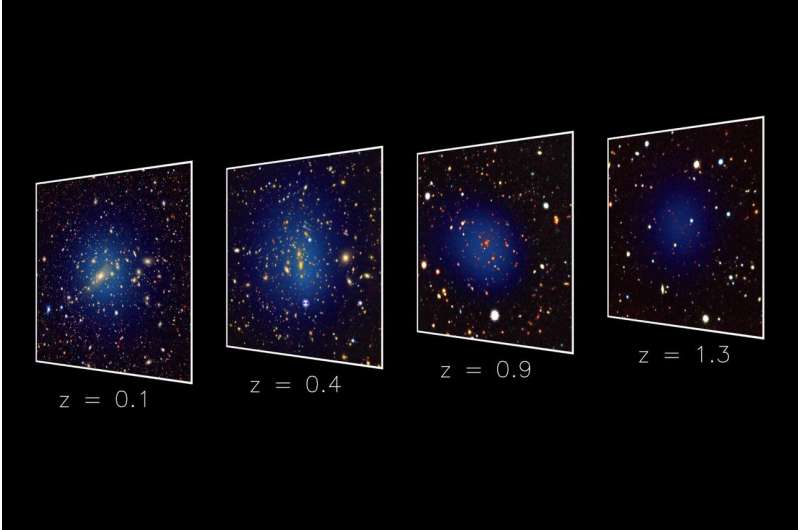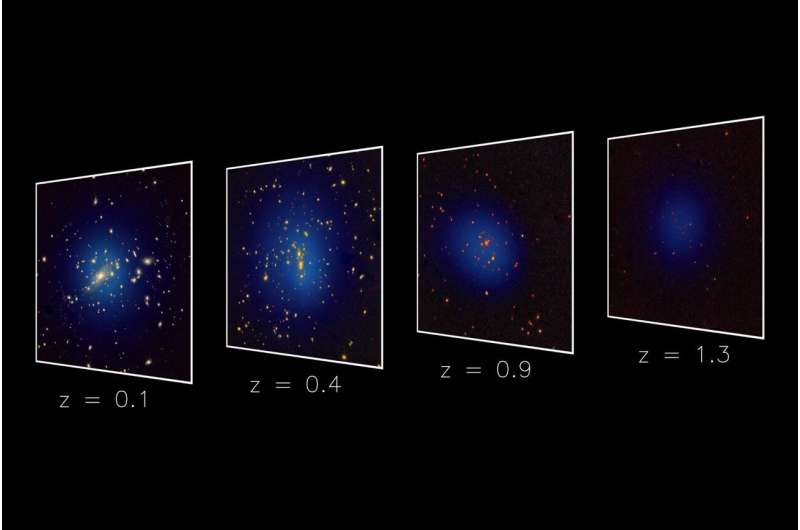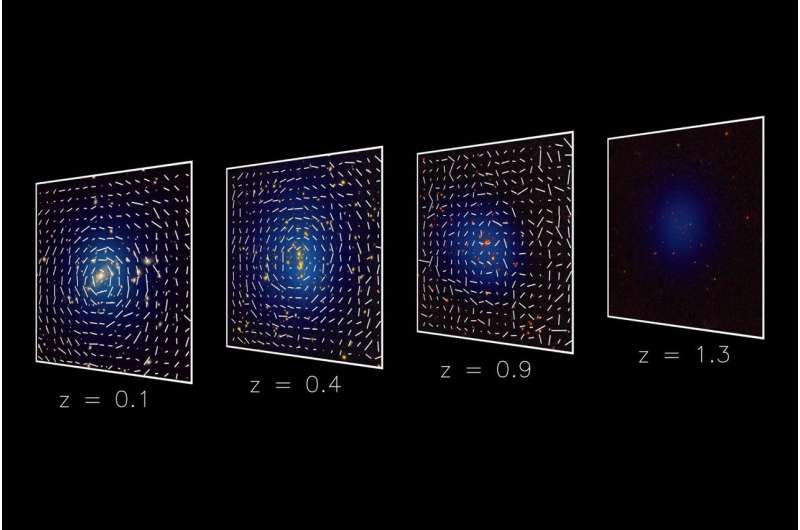This article has been reviewed according to Science X's editorial process and policies. Editors have highlighted the following attributes while ensuring the content's credibility:
fact-checked
preprint
trusted source
proofread
eROSITA X-ray sky survey measurements show consistency with the cosmic microwave background

The analysis of how galaxy clusters, the largest objects in the universe, evolve over cosmic time has yielded precise measurements of the total matter content and its clumpiness, report scientists of the German eROSITA consortium, led by the Max Planck Institute for Extraterrestrial Physics and with participation of the University of Bonn.
The results affirm the standard cosmological model and alleviate the so-called S8 tension, while at the same time offering insights into the elusive neutrinos' mass. The analysis is based on one of the largest catalogues of galaxy clusters and superclusters. An important pillar in the analysis is the "weighing" of the discovered galaxy clusters, for which the University of Bonn was a major contributor.
eROSITA is an X-ray space telescope onboard the Spectrum-RG satellite, launched in July 2019. Two weeks ago, the German eROSITA consortium released its data from the first all-sky survey. The survey's primary goal is to better understand cosmology via the measurement of the growth over cosmic time of clusters of galaxies, some of the largest structures in the universe.
Tracing the evolution of clusters via the X-rays emitted by hot gas as detected by eROSITA combined with robust mass measurements of these clusters through weak gravitational lensing, precise and accurate measurements of both the total amount of matter density in the universe and its clumpiness have been made. While past clumpiness measurements using different techniques, specifically the cosmic microwave background (CMB) and the so-called Cosmic Shear appeared inconsistent with each other, the eROSITA measurements now show consistency with the CMB.
"eROSITA has now established cluster evolution measurement as a tool for precision cosmology," said Dr. Esra Bulbul (MPE), the lead scientist for eROSITA's clusters and cosmology team who delivered the groundbreaking results. "The cosmological parameters that we measure from galaxy clusters are consistent with state-of-the-art CMB showing that the same cosmological model holds from soon after the Big Bang to today."

According to the standard cosmological model, called the Lambda Cold Dark Matter (ΛCDM) model, the infant universe was an extremely hot, dense sea of photons and particles. Over the course of cosmic time, tiny density variations grew into the large galaxies and galaxy clusters we can see today. The eROSITA cluster observations show that matter of all kinds (visible and dark) comprises 29% of the total mass/energy budget of the universe, in excellent agreement with the values obtained from measurements of the CMB, which was emitted when the universe first became transparent.
As well as measuring the total matter density in the universe, eROSITA has also measured the clumpiness of the matter distribution, described via the so-called S8 parameter. An important development in cosmology in recent years has been the so-called "S8 tension." This tension arises because CMB experiments measure a higher S8 value than, e.g., Cosmic Shear surveys.
New physics is implied unless this tension can be resolved, and eROSITA has done just that. "eROSITA tells us that the universe behaved as expected throughout cosmic history," says Dr. Vittorio Ghirardini, the postdoctoral researcher at MPE who led the cosmology study posted to the arXiv preprint server. "There's no tension with the CMB—maybe the cosmologists can relax a bit now."
The largest objects in the universe also carry information about the smallest particles: neutrinos. These lightweight particles are nearly impossible to detect. From the abundance of the largest dark matter haloes in the universe the eROSITA team have obtained tight constraints on the mass of the lightest known particles. The eROSITA cluster results yield the tightest combined neutrino mass measurement to date from any observational cosmology probe.

An important component of the analysis are weak gravitational lensing measurements. This effect describes coherent distortions that are imprinted onto the observed shapes of distant galaxies when their light rays pass through the gravitational field of foreground structures. While Cosmic Shear studies probe the effect along random directions, it can also be measured in the vicinity of galaxy clusters to estimate their masses.
The eROSITA team has conducted such measurements incorporating data from three current weak gravitational lensing surveys, the Dark Energy Survey (DES), the Hyper Suprime Cam Survey (HSC), and the Kilo-Degree Survey (KiDS). These measurements calibrate the relation between the eROSITA X-ray signal and cluster mass, thereby enabling the comparison to cosmological model predictions.
"I'm proud of the weak lensing team that did an excellent job in providing the analysis from all three leading weak lensing surveys for the eROSITA cluster mass calibration, which enabled these cosmology constraints; something that has never been achieved before" says Prof. Dr. Thomas Reiprich from the Argelander Institute for Astronomy (AIfA) at the University of Bonn, who led the weak lensing mass calibration work package within the eROSITA cluster and cosmology team from 2019 till the end of 2023.
He also is a member of the Transdisciplinary Research Area (TRA) "Matter" of the University of Bonn. The analysis of the "KiDS" weak lensing survey and also the detailed comparison between all three of the surveys is presented today in a paper, also posted as a preprint on arXiv and led by Florian Kleinebreil, Ph.D. student in the group of Prof. Dr. Tim Schrabback.
A major part of this work was conducted at AIfA, until both moved to the University of Innsbruck in the fall of 2022. "We found that the three lensing surveys yield consistent mass constraints for the eROSITA clusters, providing an important consistency test for the overall analysis," explains Kleinebreil.
"The completed analysis demonstrates the outstanding cosmological constraining power provided by combined analyses of state-of-the-art galaxy cluster samples and weak lensing surveys. Excitingly, this field will further advance in the coming years, also thanks to the arrival of next-generation weak lensing programs, including the one conducted by ESA's new space telescope Euclid," adds Schrabback.
More information: V. Ghirardini et al, The SRG/eROSITA All-Sky Survey: Cosmology Constraints from Cluster Abundances in the Western Galactic Hemisphere, arXiv (2024). DOI: 10.48550/arxiv.2402.08458
Florian Kleinebreil et al, The SRG/eROSITA All-Sky Survey: Weak-Lensing of eRASS1 Galaxy Clusters in KiDS-1000 and Consistency Checks with DES Y3 & HSC-Y3, arXiv (2024). DOI: 10.48550/arxiv.2402.08456
Journal information: arXiv
Provided by University of Bonn



















